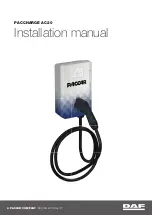
3-39
OPERATING YOUR VEHICLE
79K20-03E
When you turn off the engine, however, the
malfunction indicator resets. It takes about
ten minutes after restarting the engine for
the malfunction to be detected again and
for the light to start flashing.
TPMS Limitations
The tire pressure monitoring system may
not function properly under certain circum-
stances. In the following situations, the low
tire pressure warning light may come on
and remain on or may blink.
• When you replace a flat tire with the
spare tire.
• When you include the spare tire during a
tire rotation.
• When the TPMS sensor is damaged dur-
ing a tire replacement or liquid sealants
are used to repair a flat tire.
• When the TPMS sensor’s electronic sig-
nal is disturbed in one of the following
ways:
– Electric devices or facilities using simi-
lar radio wave frequencies are nearby.
– A lot of snow or ice covers the vehicle,
in particular, around the wheels or
wheel housings.
– Snow tires or tire chains are used.
• When you use non-genuine SUZUKI
wheels or tires.
Replacing Tires and/or Wheels
If you get a flat tire, Suzuki recommends
that you have an authorized SUZUKI
dealer mount a new tire on the wheel that
had the flat tire, and reinstall this tire on the
vehicle in place of the spare. The TPMS is
already set up to recognize the ID code of
the original wheel, and normal TPMS oper-
ation will be restored.
If you wish to operate your vehicle with the
spare tire installed, you must have an
authorized SUZUKI dealer set up the
TPMS to recognize the ID code of the
spare tire TPMS sensor.
If you need to replace any wheels on your
vehicle, your dealer must make sure that
TPMS sensors are installed in the new
wheels and must set up the TPMS to rec-
ognize the new sensors.
WARNING
The TPMS malfunction indicator is
combined with the low tire pressure
telltale. When the system detects a
malfunction, the telltale will flash for
approximately one minute and then
remain continuously illuminated.
This sequence will continue upon
subsequent vehicle start-ups as long
as the malfunction exists.
WARNING
When the malfunction indicator is
illuminated, the system may not be
able to detect or signal low tire pres-
sure as intended. TPMS malfunctions
may occur for a variety of reasons,
including the installation of replace-
ment or alternate tires or wheels on
the vehicle that prevent the TPMS
from functioning properly. Always
check the TPMS malfunction telltale
after replacing one or more tires or
wheels on your vehicle to ensure that
the replacement or alternate tires and
wheels allow the TPMS to continue to
function properly.
CAUTION
• The tire pressure sensors can be
damaged by the installation or
removal of tires. When tires must
be repaired or replaced, we highly
recommend that you have them
repaired or replaced by an autho-
rized SUZUKI dealer.
• Do not use liquid sealants for a flat
tire as air pressure sensors can be
damaged.
• If the low tire pressure warning
light comes on frequently, there
may be something wrong with one
of the tires or with the monitoring
system. Have your vehicle
inspected by an authorized SUZUKI
dealer.
Содержание 2009 Grand Vitara
Страница 6: ...79K20 03E MEMO...
Страница 15: ...FUEL RECOMMENDATION 1 79K20 03E 65D394 FUEL RECOMMENDATION Fuel Recommendation 1 1...
Страница 140: ...3 41 OPERATING YOUR VEHICLE 79K20 03E MEMO...
Страница 150: ...4 9 DRIVING TIPS 79K20 03E MEMO...
Страница 282: ...8 11 EMERGENCY SERVICE 79K20 03E MEMO...
Страница 283: ...APPEARANCE CARE 9 79K20 03E 60G412 APPEARANCE CARE Corrosion Prevention 9 1 Vehicle Cleaning 9 3...
Страница 288: ...9 5 APPEARANCE CARE 79K20 03E MEMO...
Страница 294: ...10 5 GENERAL INFORMATION 79K20 03E MEMO...
Страница 298: ...11 4 FUSES AND PROTECTED CIRCUITS 79K20 03E MEMO...
Страница 308: ...13 6 INDEX 79K20 03E MEMO...
Страница 309: ...79K20 03E Prepared by June 2008 Part No 99011 79K20 03E Printed in Japan TP306...
















































